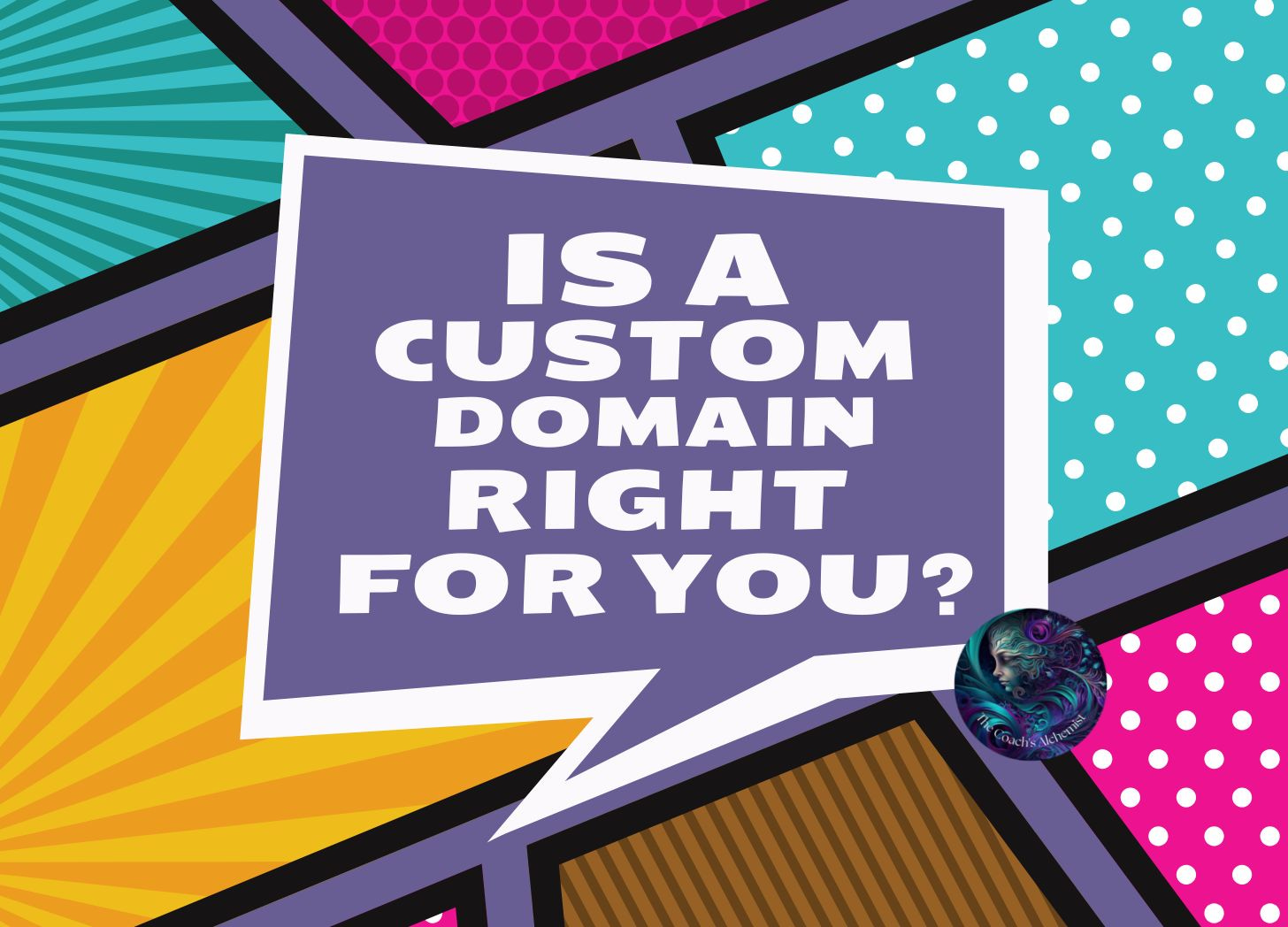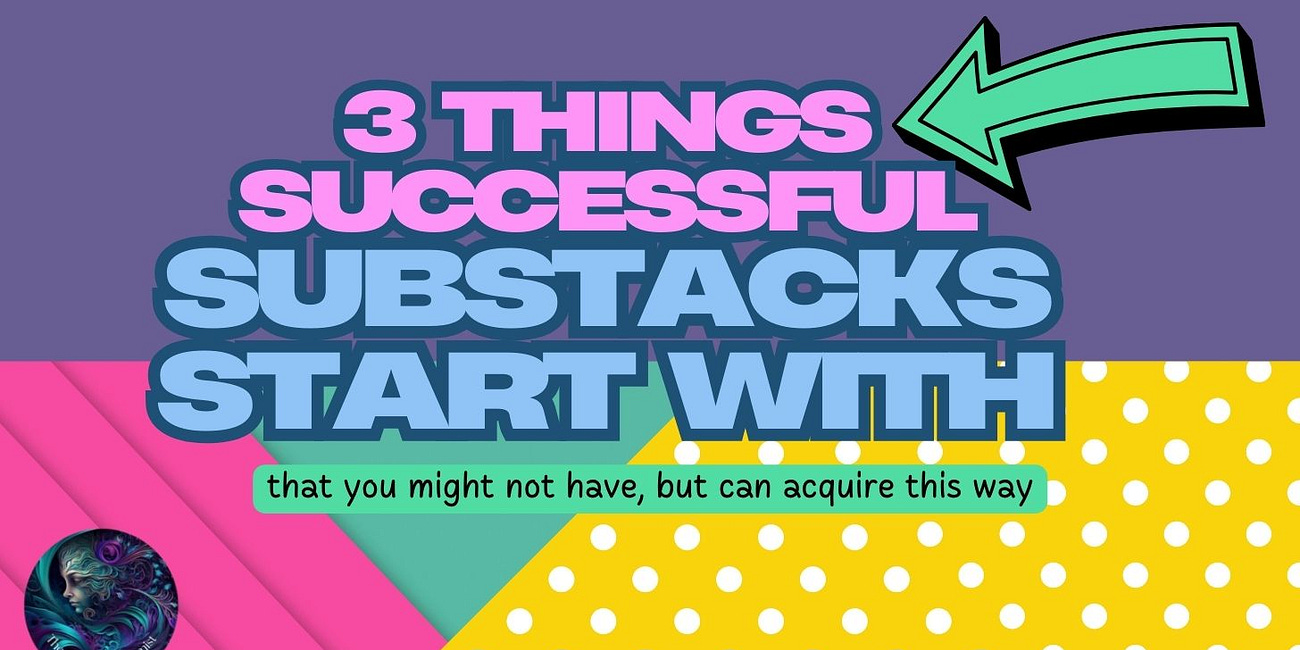Custom Domain or No Custom Domain
Things to consider and genius solution
Kristi over at
was discussing the pros and cons of using a custom domain.And she prompted me to weigh in on the topic.
I had at one point been thinking about this option.
Though because I’m pretty techy, and the process is technical, actually changing to a custom domain, for me, wasn’t as daunting as the thinking about the repercussion and making a decision.
Here’s what unraveled in the thinking process…
First Off; What It Means to Have a Custom URL
A custom URL is a dedicated URL for your Substack. Rather than have yourname.substack.com, you would have a url that was say, yourname.com.
The yourname.com url is way easier to remember right?
That said…
Switching to a custom domain on Substack has some drawbacks within the platform itself. Here are the key considerations:
Loss of Substack’s Built-in Network Effect
Substack has a discovery feature where readers can find and subscribe to newsletters within the platform.
If you switch to a custom domain, your newsletter may not appear as prominently in Substack’s internal recommendations.
Readers won’t see “other newsletters” recommendations that typically appear under your posts, potentially reducing organic growth.
SEO & Search Engine Indexing Delays
While Substack automatically redirects old links, search engines still need time to re-index your new domain.
Your previous search rankings could drop temporarily.
If you later switch back to Substack’s default URL, your SEO rankings might be impacted again.
RSS & Embed Limitations
If you have readers subscribed via RSS, they might need to update their feed URL manually.
Some third-party embeds (like podcast players or external integrations) may not update automatically—check your embedded content.
Email Deliverability & DNS Settings
You’ll need to configure DNS records properly to avoid email issues (especially if you use a custom newsletter email).
If set up incorrectly, email delivery could be affected, leading to newsletters landing in spam.
Custom domains do not support Substack’s built-in email domain authentication (SPF, DKIM, DMARC), so you must configure it yourself.
Potential URL Breakage if You Revert
If you decide to switch back to Substack’s default URL later, all your custom domain links will break.
You’ll lose any SEO rankings gained under your custom domain.
You won’t be able to redirect your custom domain URLs back to Substack’s free URL.
No More Free Substack Branding Perks
If you’re using a custom domain, Substack won’t prominently feature your newsletter on its site.
Your newsletter won’t get the "substack.com" trust factor, which some new readers recognize. And it might impact deliverability of your newsletter overall.
Analytics & Third-Party Tool Compatibility
Substack’s built-in analytics remain the same, but if you rely on external tools like Google Analytics or SEO tracking, you may need to reconfigure them.
Some external tracking tools may need manual re-integration with your new domain.
Let’s Look at How Google Indexes Substack Content
Google continues to be a HUGE part of the backbone of being found (they even own YouTube in case you didn’t know). When it comes to thinking about creating a custom domain, we MUST think about how it will impact Google
Substack newsletters (with the default substack.com domain) benefit from Substack’s overall domain authority. This is a HUGE deal. Domain authority is one of the important ranking factors for getting found in Google.
This is especially true if you don’t have a high-ranking domain (website) to backlink to as some big brands do.
3 Things Successful Substacks Start With
Though I’ve been hanging around on Substack for over two years now, it’s only been in the last few weeks I’ve decided to go all in. This is what I discovered…
Each newsletter acts as a subdomain (e.g., yoursubstack.substack.com), meaning its SEO is somewhat independent but still tied to Substack’s broader domain reputation.
Substack pages are indexed individually, so each post can appear in search results based on its own content quality, keywords, and backlinks.
Get the Podcasting on Substack: The Essential Guide for Coaches & Creators - there are directions for connecting your Substack to Google Search
What Happens When You Switch to a Custom Domain?
SEO Authority Reset (Partial)
You move from substack.com to your own domain (e.g., yourname.com).
▶️Your custom domain starts fresh with zero domain authority in Google’s eyes.
▶️You lose the indirect SEO benefits of Substack’s domain authority.
▶️Your existing posts need to be re-indexed under the new domain.
Automatic Redirects Help, But Not Instantly
▶️Substack automatically redirects old links to your new domain.
▶️However, Google takes time to recognize the new domain as the same entity.
▶️There might be a temporary drop in rankings and traffic until Google fully re-indexes your content.
Loss of Internal Substack SEO Perks
▶️Substack’s built-in recommendation system links newsletters within substack.com, creating internal backlinks that boost SEO.
▶️With a custom domain, you exit that internal linking network, meaning fewer backlinks from Substack itself.
Improved Long-Term Branding & SEO Potential
▶️A custom domain allows you to build your own domain authority over time.
▶️If you focus on SEO best practices (backlinks, internal linking, structured metadata), you can eventually outperform the default Substack setup.
Think About These Before Switching
👉If most of your traffic comes from Google search, you may experience a temporary dip in rankings.
👉If you rely on Substack’s discovery and recommendations, switching to a custom domain removes some of that organic exposure.
👉If you plan to build a long-term brand outside of Substack, switching makes sense despite the temporary SEO setback.
- of - suggests using a Redirect for your custom domain - and I personally think this is a GENIUS solution.
If you're considering switching to a custom domain for your Substack but are concerned about SEO, existing links, and discoverability, the best approach is to forward your custom domain instead of fully switching your Substack URL. Here’s why:
You Keep Substack’s Built-In SEO Benefits
👉Substack.com has strong domain authority, meaning Google prioritizes its subdomains in search results.
👉If you switch to a custom domain, you start from scratch, losing the SEO weight of substack.com.
👉By forwarding instead of switching, you keep your existing Substack URL indexed while still offering users a branded domain.
✅ Best of Both Worlds: You benefit from Substack's domain strength while presenting your own brand.
Avoids Google Reindexing Delays & Ranking Drops
👉When you change your domain, Google must re-index your entire site, causing temporary SEO setbacks.
👉It can take weeks to months for your new domain to regain rankings.
👉If you simply forward the custom domain to your Substack URL, Google doesn’t need to reindex anything, preserving your rankings.
✅ No lost rankings. No waiting for Google to catch up.
All Existing Links Stay Intact (No Broken Links or Redirect Issues)
👉If you switch domains, all previous links shared on social media, podcasts, guest posts, etc., point to the old URL.
👉Even though Substack automatically redirects old links, search engines take time to process those changes.
👉With domain forwarding, all your existing backlinks remain valid, ensuring you don’t lose any traffic.
✅ No broken links, no lost referral traffic, no SEO disruption.
You Keep Substack’s Built-In Discoverability
👉Substack has a built-in discovery system that recommends newsletters within substack.com.
👉If you switch to a custom domain, you lose this internal linking benefit.
👉Forwarding keeps you in the Substack ecosystem while offering a branded experience.
✅ Stay part of Substack’s network while looking professional.
Easier to Manage & Less Technical Hassle
👉Setting up a fully custom domain requires DNS changes, email configurations, and possible downtime.
👉Forwarding a domain is simple—just set up a 301 redirect through your domain registrar (e.g., GoDaddy, Namecheap, Cloudflare).
👉No need to worry about SSL certificates, Google reindexing, or email setup issues.
✅ Quick and easy setup with no maintenance headaches.
Future-Proofs Your Brand
👉If you ever want to leave Substack, your audience is already familiar with your custom domain.
👉You can later switch to a self-hosted site (WordPress, Ghost, etc.) and use the same domain.
👉No need to retrain your audience—your brand stays consistent.
✅ Keeps your brand independent without losing Substack’s benefits.
Final Verdict: Forwarding = The Smart Move
💡 Instead of fully switching your domain, forward it to your Substack URL.
✅ Best Choice If:
✔ You want SEO benefits from Substack’s authority.
✔ You don’t want to lose rankings or backlinks.
✔ You want a professional-looking URL (e.g., YourName.com instead of YourName.substack.com).
✔ You want an easy transition in the future if you ever leave Substack.
🚀 How to Forward Your Domain:
Go to your domain provider (GoDaddy, Namecheap, Cloudflare, etc.).
Look for the Domain Forwarding option.
Set it to 301 redirect your domain to yourname.substack.com.
Save and test the redirect.
✨ Now, when someone types YourName.com, they are instantly forwarded to your Substack without breaking links or losing SEO. 🎉









Man, you're quick for a Saturday morning 😁😁 Thanks so much for writing this. I'm going to edit my post and add a link to this one if you don't mind. People love options and advice, this is great!
We have such a supportive community...I love this place.
This is very helpful. I was evaluating switching to a personal domain but your post made a lot of sense. Thank you.